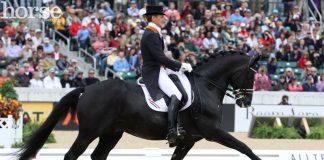
Anyone who rides for any length of time quickly realizes the value of circles. This simple tool develops symmetry in the horse’s spinal stabilizing muscles, creates flexibility through his trunk, and helps him become more balanced, not to mention it can also help calm down his emotions when needed.
Getting it Round
So how can we go about improving egg-shaped figures, or ones with varying speeds from start to finish? I find that riders don’t necessarily make progress when they repeat dozens of circles trying to make them better.
Instead, using some key exercises to help approach circles more effectively does the trick. The following three exercises can help guide you to make circles that are not only more technically correct but also more gymnastically beneficial for your horse.
Accurate geometry matters because it ensures the horse consistently employs the targeted muscle groups for the duration of the circle. When a figure gets wobbly or disorganized, the horse alters which muscles he uses every few seconds. No gains are made in the intended areas of his musculoskeletal system. A correctly round circle causes the horse to engage the postural muscles that stabilize his spine while in motion.
Bodybuilding on a Circle
Back muscles on the inside of the curve have to contract while those on the outside need to lengthen. Simultaneously, his oblique muscles on the sides of the ribcage engage to balance the trunk. These muscles help the horse lift his back and move freely with his hind legs. Also, the inside hip lowers and moves forward, which increases load on that respective leg creating strength and power.
Use the following exercises to find your way to perfect circles, and your horse’s body will thank you in return.

Exercise No. 1: Circle-Square
This exercise helps keep the horse organized between the guideposts of the rider’s legs, especially the outside leg that shows him the boundary of the circle.
Many circles go wrong because the horse drifts outward and enlarges one side of the figure. Using quick variations in figures, this exercise prevents that.
- Begin by riding once around a 20-meter circle in working trot or jog.
- Then immediately ride a 20-meter square.
- Aim to ride the sides of your square very straight and the corners nearly 90 degrees.
- Then go back to your 20-meter circle, riding once around it.
- Repeat the square.
- Continue this sequence until both figures improve.

Exercise No. 2: Separated Half-Circles
This routine emphasizes quality and precision by repeating the best parts of a circle: the first half. It asks riders to execute a perfect half-circle and then ride forward down the arena to do it again, thereby preserving forward energy and alignment.
It keeps the rider’s and horse’s balance and bend correct by not leaving them on the circle so long it falls apart. This simple little routine can help horses learn to organize themselves well, especially in the canter.
- Begin in a working trot or canter at A, tracking right.
- Proceed down the rail to E and ride a 20-meter half-circle to B.
- At B, proceed straight ahead.
- At A, ride a 20-meter half-circle.
- Proceed around the arena to B and ride a 20-meter half-circle.
In between each half-circle, run through your checklist of items to get organized: How is the horse’s rhythm? Are you looking forward? Is the contact equal in both reins? Is the horse’s gait remaining steady from the half-circle to the straight line and then back to the half-circle?

Exercise No. 3: Diamonds
By interspersing tiny straight lines along the curve of the circle, this exercise helps riders coordinate the interplay of inside and outside aids. It nearly always improves the accuracy of circles, particularly because it sharpens your navigation by using cone markers.
This exercise is especially useful for horses that ride stiffer and more crooked in one direction; it allows them to benefit from the circle without getting resistant about the challenges of a continuous curved line.
- Place cones as noted in the diagram.
- Proceed around the “circle” in working trot or canter.
- Ride directly from each cone to the next one without allowing your line of travel to curve outward.
- Continue riding from cone to cone, aiming to hit them like targets.
- After three or four times around your figure like this, now ride a circle around the outside of the cones. It should feel easy after the diamond!
A circle seems so simple, but the gymnastic value of circles for horses is what makes them so difficult. Without symmetrical muscling, many horses will create compromised ways of riding around circles. In fact, many of them will become anxious or tense when they feel the rider prepare for a circle. And unfortunately, many of us guide our horses to poor circles because of uncoordinated aids or timing.
By riding circles on a daily basis, both horse and rider improve. The caveat, though, is that this happens only by practicing the best circles possible. These featured exercises will help you do just that. By reinventing the circle, your riding finesse will grow and your horse’s mental and physical balance will improve. So, happy circling!
JEC ARISTOTLE BALLOU is the author of 101 Dressage Exercises for Horse & Rider and Equine Fitness. www.jecballou.com
This article originally appeared in the October 2017 issue of Horse Illustrated magazine. Click here to subscribe!






[…] Bron: Horse-illustrated […]